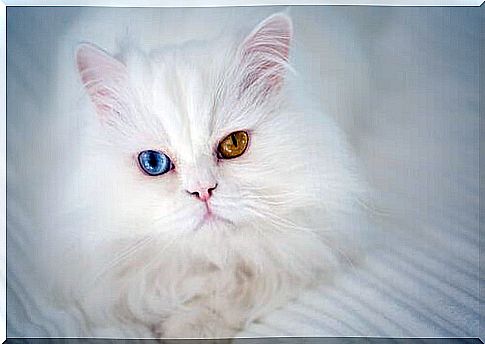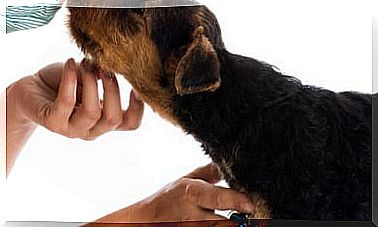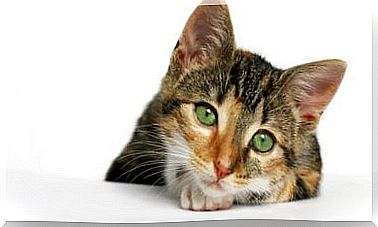Heterochromia In Cats And Dogs

There is an anatomical condition that causes the iris of the eyes of a human or an animal to be of a different color from the other. But what is heterochromia in cats and dogs ? What is it due to? How does it manifest itself?
We have decided to dedicate an article to this interesting topic that, perhaps, will interest your four-legged friend. Knowing better about heterochromia in dogs and cats will allow you to understand what is much more than a simple aesthetic feature.
All about heterochromia in cats and dogs
This chromatic anomaly can also affect the coat or skin, but it is more common to see it at eye level. It can manifest itself in two ways, such as heterochromia iridis and heterochromia iridum . In the second case, the color difference is within the iris of the same eye.
The cause of heterochromia iridis is an excess or scarcity of melanin, but it does not affect the quality of vision. In most cases, it occurs in puppies and for genetic reasons. There are usually three types of heterochromia in cats and dogs:
- Complete : it is the most common and has two eyes of different colors.
- Partial or sectoral : Only some colors of the iris differ, due to hereditary conditions such as Waardenburg syndrome or Hirschsprung’s disease.
- Central : the center of the iris has a different color from that of the mid-peripheral part.
White-haired or spotted animals tend to have this characteristic. But, in any case, heterochromia can appear in dogs and cats of different colors and breeds.
How does heterochromia manifest in cats?
Complete heterochromia is more common in cats, especially those with a dominant white or white-spotted epistatic gene. This is what generates specimens with two-tone fur. In general, these animals have one eye that is blue and the other is green, yellow, or copper. But there are also cases of felines with different colors in the same eye.

There is no direct relationship between deafness and heterochromia. Most of the specimens with different colored eyes – about 70% – do not have hearing problems. However, white cats with one or both blue eyes are more prone to suffering from this problem.
Keep in mind that domestic cats are born with blue eyes – due to a lack of melanin – but their true color appears between 7 and 12 weeks of age.
Heterochromia in cats is more common in the following breeds:
- Angora
- Persian
- Japanese Bobtail
- Turkish Van
- Khao Manee
- Sphynx
- British Shorthair.
Heterochromia in dogs
Dogs can also have complete heterochromia. This condition usually occurs in breeds such as the Siberian Husky, Dalmatian or Australian shepherd.

Partial heterochromia, on the other hand, usually also appears in Australian shepherds and in specimens of :
- Border Collie
- Great Dane
- Welsh corgi (Pembroke)
However, dogs don’t need to be purebred to develop this condition. Heterochromia can also appear indiscriminately in mestizo specimens.
More information on eye coloring
Not everyone knows that different colored irises can also be due to other causes. Between these:
- Injury, bleeding, inflammation or the presence of foreign objects in the eye
- Genetic mosaicism
- Glaucoma
- Some medications
In any case, at the slightest doubt, it is necessary to consult the veterinarian to determine if the pet should undergo any treatment or special care.
The truth is that dogs and cats with this characteristic, regardless of their pedigree , attract attention due to this “anomalous” coloration of their eyes. But which, at the same time, makes them even more special and unique. If you have a pet with heterochromia, you just need to make sure that this condition does not hide any pathology.









